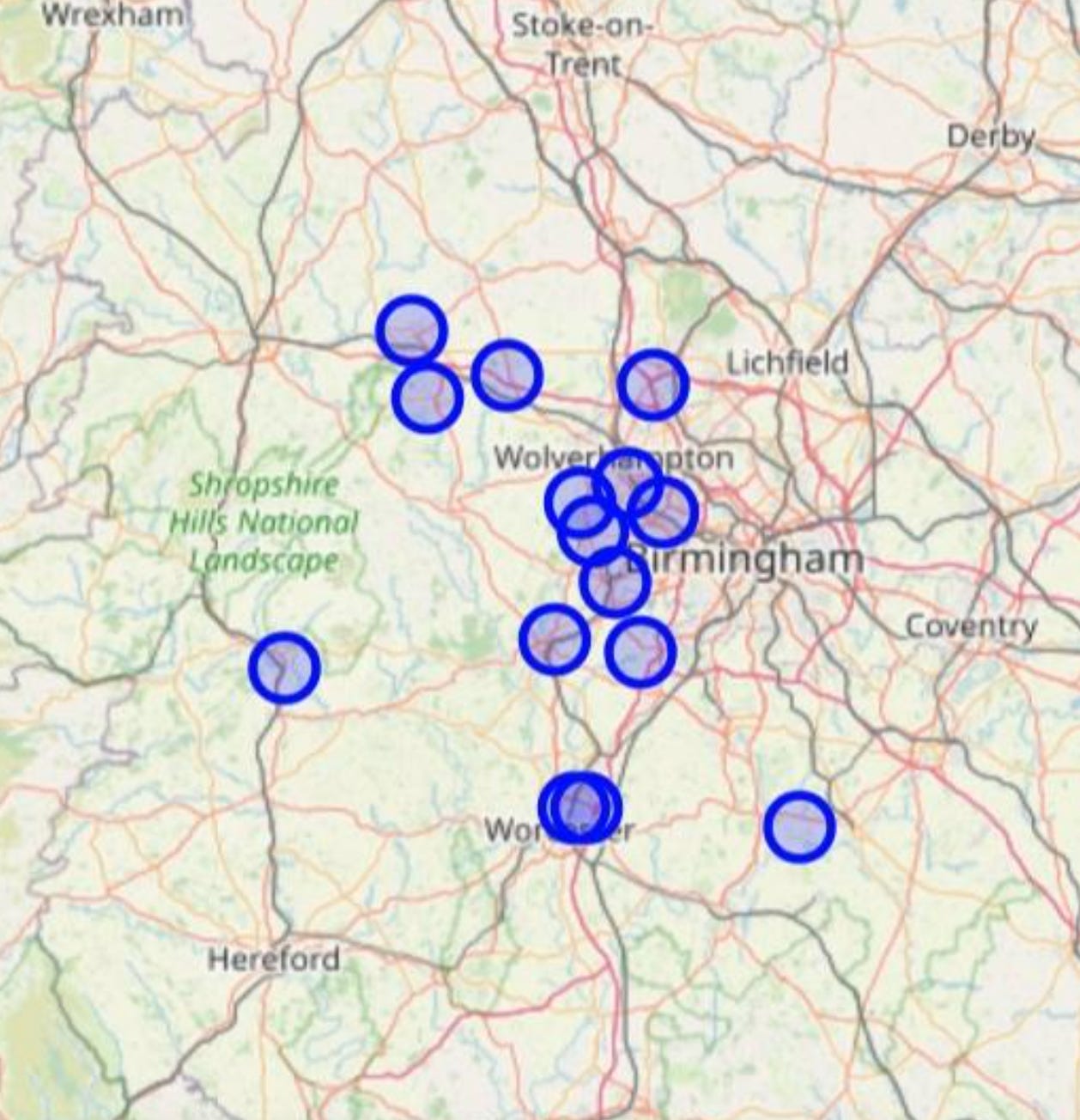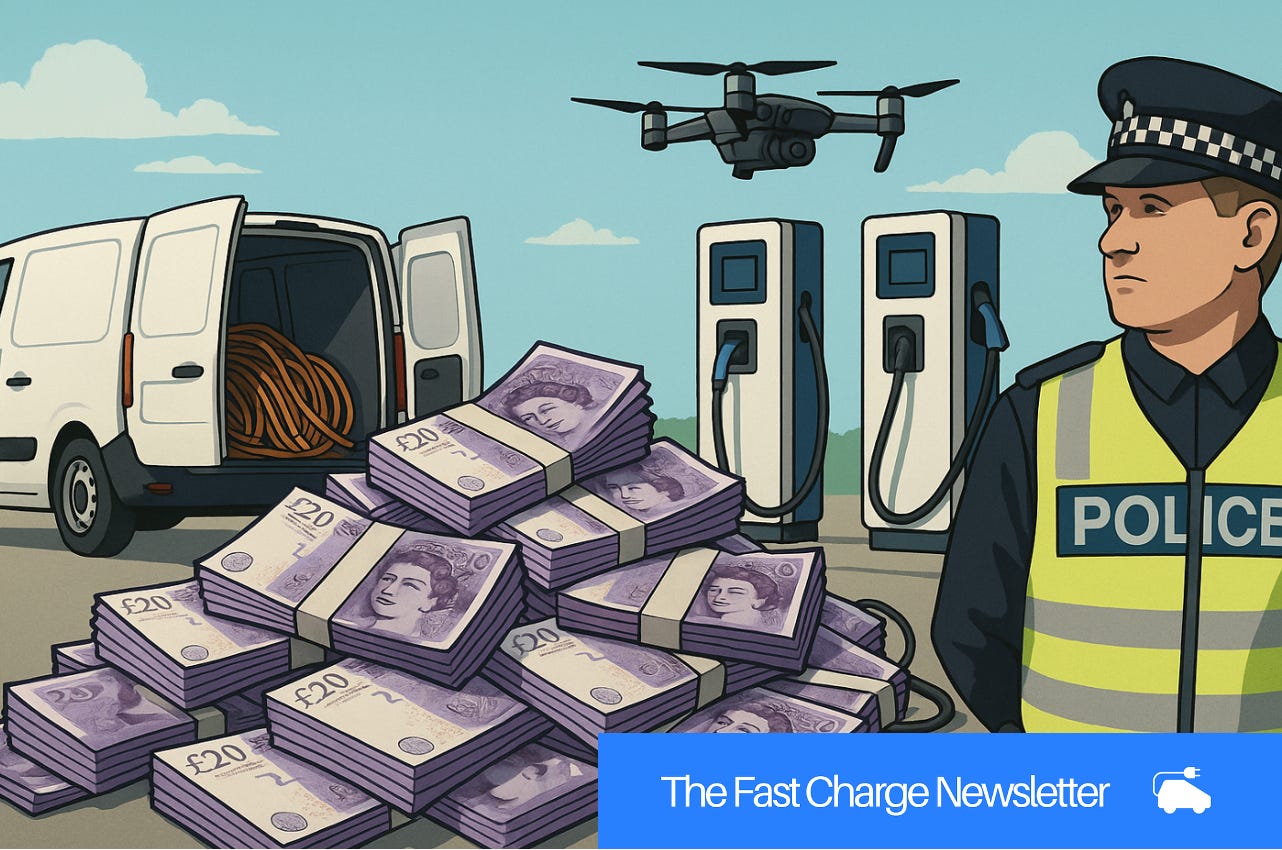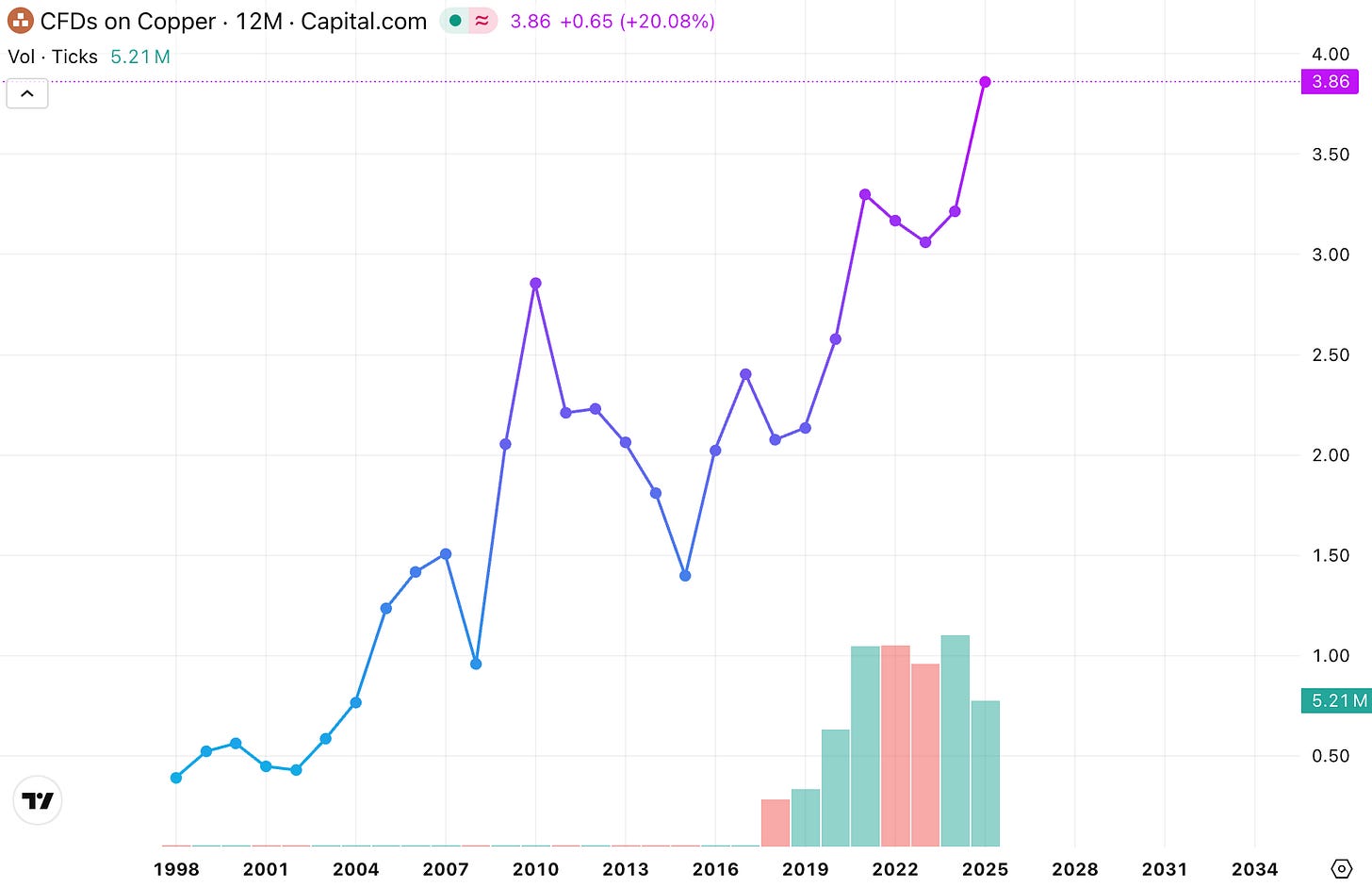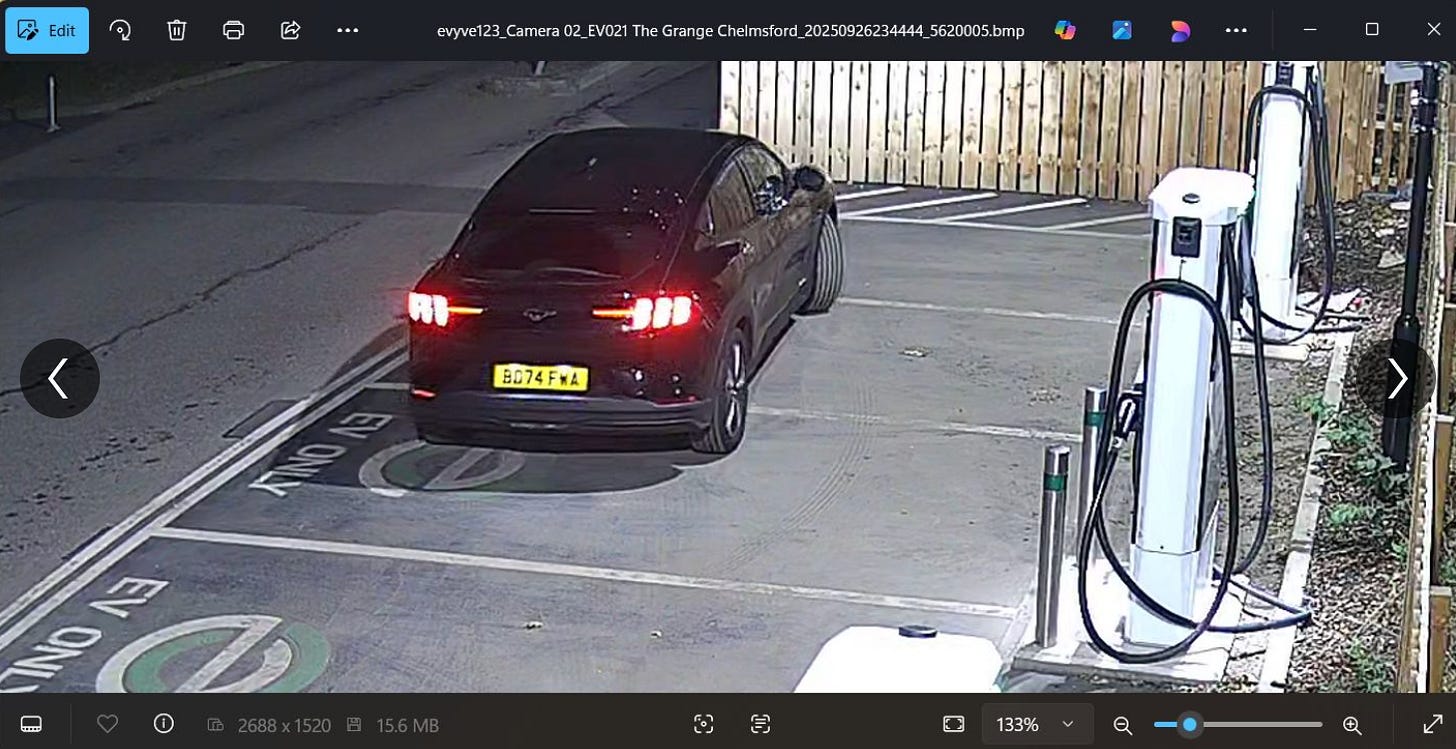Sex, Drugs & Cable Theft: How EV charging became a criminal cash cow
A special deep dive on the 'epidemic' costing UK businesses millions
Hello, I’m Tom Riley, and welcome to a special edition of The Fast Charge EV Newsletter.
This article is an in-depth look at the surging “epidemic” of cable theft, a crime that is shaking driver confidence and costing UK public charging networks millions, as businesses plead for the Police to take stronger action and bring in tougher sentences.
So, slip on the soundtrack to Oceans Eleven, and settle into this epic 3,000-word look at gangland’s latest cash cow: snatching charging cables 🔌
As ever, if you have any comments or feedback, please reply to this email or message me on LinkedIn.
Sex, Drugs & Cable Theft 🌶️💉🔌
How EV charging became organised crime’s cash cow.
It’s Springtime 2025 in the West Midlands, and at a supercar salesroom outside Birmingham, a local scrap metal dealer is about to take delivery of a bright green Lamborghini Huracan.
The dealer in question owns incredibly popular social media channels that have more than a hundred thousand followers between them. You only need to search ‘copper buyer’ on TikTok to come across their content promoting the buying and selling of scrap metal.
The dealer’s most viral and top-pinned TikTok video, with more than three million views and 80,000 likes, shows off an Enterprise van stacked with so much copper wire the tyres are almost deflated – something pointed out in the video. It’s later stated this haul was bought by the dealer for an eye-popping £44,000, due to its high grading and quantity.
I am not suggesting there is anything untoward going on here; I just wanted to use this as an example of how lucrative a business recycling metals is becoming in the UK. And no metal is more precious right now than copper.
We’re living in a ‘copper rush’ 🤑
I have been a best man twice, and both times meant a trip to Hatton Gardens to go shopping for diamond rings. Anyone who has done that will be familiar with what it entails: enduring hours of slick sales chat and cockney charisma wrapped around a confusing lexicon of carats, colours, and purities. It’s little wonder we assume they’re rare and pay top dollar, despite them serving no material purpose.
Meanwhile, copper, while by no means rare, is hugely valuable precisely because it is so useful.
As we’ve flown into the age of electronics, copper wiring – from telecoms to pylons – has become essential to keep us moving. The orange-coloured soft metal is the ultimate conductor. Without it, countries like the UK will have no chance of electrifying and hitting our climate ambitions as we move on from fossil fuels.
While most copper in our devices and infrastructure is built into products abroad, much of it is increasingly coming to our shores. Whether in cables to charge your phone, or the substations powering our homes. And at the end of their ‘life’, much of this ends up going to scrap plants who, at scale, can make big returns.
It’s hard to quantify the exact UK industry value for scrap copper, but one analyst suggested it was £272 million in 2023, with the expectation of it growing to £412 million by 2030. This rise is being driven by the rising demand over that period to go net zero and adopt new technology like AI.
At the moment, if you were to turn up to a scrap yard with a bunch of ‘dry bright copper’ (aka, copper from within a cable), you could get £6.70 per kilo as of 28 October, according to UK Metals. However, as this metal is so valuable, dealers are willing to go over that to ensure they get it. One dealer I found in the West Midlands is offering £7.15 per kilo.
Why? Well, this October, the price for Contracts for Difference on copper hit the highest level since records began. It’s no surprise that prices in the yard are spiralling upwards, and perhaps explains why, when the dealer from earlier came to sell his Lamborghini, on TikTok, he said he’d be happy to exchange it for the right amount of copper.
This rush has criminal consequences 😈
Based on my analysis of public registers, it’s believed there are approximately 1,300 ‘active’ scrap metal yards in operation across the UK – 1,242 of those are in England and Wales.
All of these sites are bound by serious regulations, not least the Scrap Metal Dealers Act of 2013. A piece of legislation that was introduced a decade ago when criminals, in the shadow of a recession, took advantage of high copper prices – fuelled by investors shoving huge amounts into the commodity on the back of China’s huge growth – by taking apart the UK’s recently electrified railways and selling them for quick cash.
It ground the UK railways to a halt, and the new laws set out to curtail the activity by ensuring transactions for metal occurred via bank transfer (BACS). While that theft has reduced, it has not disappeared. It’s widely accepted by many I’ve spoken to – whether in law enforcement or a business – that not all scrap dealers play by the rules. And with shrinking budgets, many local authorities simply don’t have the resources to monitor them properly.
In the UK, we are currently facing the same economic conditions as 15 years ago. The cost of living remains high, and people are not spending. This is making trading harder for all businesses, but the group who are probably really under the kosh: criminals.
Riley’s Guide to Organised Crime Gangs 🔫
Not something I ever thought to write about in this publication, but it’s important context. Organised Crime Gangs (OCGs) are everywhere throughout the UK. And while, historically, as you’d see in the movies, there were lots of gangs all doing a specific thing – such as gun dealing or robbing banks – nowadays, I’m informed by a law enforcement source that most gangs tend to run ‘portfolios’.
Yes, rather than put all their eggs in one basket, it seems many organised criminals now prefer the safety of running multiple hustles. It regularly consists of prostitution, drug dealing, human trafficking, fraud, and theft.
And this is where the current state of Britain’s economy and our national EV targets enter the frame.
These OCGs are fundamentally no different from any other business. They look at running costs, they review margins on sales, they have people to manage, fuel to pay for, specialist skills and tools to rent, contracts to handle – they’ll be spinning all manner of plates like any other enterprise. The only difference is the products they deal in.
It was made very clear to me throughout researching this piece that these gangs are not stupid. They may have ‘foot soldiers’ who smirk into CCTV screens and look a bit idiotic; however, fundamentally, the reason we’re seeing an “epidemic” of cable theft is that it’s good business for OCGs:
Copper scrap is at a record price
There are thousands of new public chargers being installed every month
The sites in question are often in poorly lit, remote, and unguarded locations
The cables are easy to steal and require few tools
Copper can be easily stripped out and is very untraceable; and
Because of contracts and lost income, they know charging networks will want to quickly replace them.
Without intending it, many large networks believe their cables have become a criminal cash cow for organised gangs - helping to fund everything from child sex work to people trafficking.

Networks are losing millions as theft surges 💷
To gain insights for this piece, I have spoken or exchanged messages with eight of the UK’s largest charging networks. These operators share similar characteristics in that they predominantly focus on rapid and ultra-rapid charging – many of them manage hundreds of hubs all around the UK. It’s these hubs and high-speed chargers that are the crème-de-la-crème for copper thieves, as their cables can be worth upwards of £100 each, given the soaring scrap price.
That figure may sound insignificant, but the way these crimes are carried out is done in such a way that over a single night or week, numerous hubs in an area can be hit by the same gang or person. One network told The Fast Charge they could easily swipe 40 cables over a week.
This crime is also easy to undertake. Most networks report that criminals spend about four minutes on site before leaving with cut cables. At that pace, the police and networks often do not stand a chance of stopping them. For the criminal gangs, the speed makes the returns very profitable: £4,000 for a few hours’ work will make it a top earner compared to other crimes.
Furthermore, the thieves often know where CCTV is, have pre-prepared routes to reach and escape hubs, use fake plates, and sometimes even pretend to be charging to avoid unwanted attention (hey, how often do you really look at a man’s shoes?). Other times, especially in urban areas, it’s much simpler, whereby a moped with two people will arrive, cut the cables, and then simply sling them over their shoulders to be dragged away.
Because of new Charge Point regulations introduced around open data in 2023, it’s also easier than ever for criminals to see when a site is occupied by cars, or what other facilities exist nearby – making arriving at a quiet time far simpler. This can mean well-lit and even staffed forecourts get attacked.

When the crime initially popped up, there was a “naïve” belief that the theft was being undertaken as one-offs by opportunists. However, as more of the crime has been witnessed on CCTV, networks have seen it’s quite sophisticated – hence the common view that this crime is now one in the organised crime ‘portfolio’ – and has quickly spread across the UK.
For example... Numerous networks have told The Fast Charge that some cables are left on-purpose, because they know which ones contain more copper. Nearly all networks reported having the same sites attacked multiple times – I heard of one site getting hit four times. For another network, only a day after their cables were reinstalled following a previous theft, they were swiped again.
This leads to another shared concern by some operators: ‘insider threat’. For one network, they experienced an attack where copper was extracted diligently from a hub’s substation – something only a trained professional could do, and only a person with knowledge that the station was disconnected would be confident to undertake.
In another example of the gang’s determination, when a thief’s bolt cutter was not getting through a cable, one network noted they simply drove away, only to return later with a more powerful tool to do the job. A brazen move, all captured on CCTV, and yet never caught.
Some networks privately believe travelling groups with established scrap-yard and OCG links are involved – this is based on their own conversations with local police forces and not anything I can confirm.
Operators are working hard to manage the crime 👊
Despite police being alerted when attacks occur, all networks told The Fast Charge they cannot rely on a blue light response. Only in one instance, that I’ve heard of, has a thief been caught in the act – and I understand that was a one-in-a-thousand fluke.
And, no, the use of ‘thousand’ is not an accident. Based on my conversations with operators, I understand the number of cables taken in the past 12 months is likely between 1,000 and 1,500. Several operators, especially larger ones, report regularly dealing with one or two attacks a week.
Independent of one another, two networks separately referred to the crime as an “epidemic” and the other a “pandemic”.
ChargeUK, the trade association for EV charging, acknowledged the crime was at an all-time high. Having only really started to be noted properly in 2023, the trade body is now monitoring it very closely.
“It adds huge cost for our members, as well as threatening to undermine driver confidence,” says Jarrod Birch, Head of Policy at ChargeUK.
The actual cost to charging networks is believed to be in the millions. Based on my conversations, the typical cost to replace each cable is estimated to be between £1,200 to £3,000 each. There are a range of factors that contribute to the final figure, including labour, having to buy fresh components, and adding any new security features to a site – a cable protector alone can add nearly £500 to £1,000 a pop.
This eye-watering cost does not consider lost revenue and reputational damage to a charging network, and the site specifically. Multiple networks complain of the time spent to launch a site for a community, and that thieves put them back to square one, having to repeatedly relaunch.
“It’s easy to focus on the business cost of the damage but the real impact falls on drivers who rely on access to this infrastructure to keep moving,” says Adrian Fielden-Gray, Chief Operating Officer at Be.EV.
Surging crime leads to innovation 💡
Charge point operators probably thought much of their innovation would go towards boosting speeds or consumer experience, yet it’s the rise in cable theft that’s become an urgent arms race to beat the criminals.
Various approaches are employed by networks. Nearly all rely on 24/7 CCTV, though not all of them are monitored live. Many are using ‘smartwater’ – which is an invisible fluid that aids tracing cables. While common in some sectors, in-person security at every location is too costly for networks, though InstaVolt pays for a security patrol of its hubs. Many networks are now also adding cable protectors to their cables, although many have tried these and found them to be ineffective.
Other networks have sought to be more inventive. Osprey, for example, has re-engineered its chargers to set off a loud alarm if cut.
Dora Clarke, Head of External Affairs at Osprey Charging, told The Fast Charge: “On the 3rd July, the Osprey tech team started on an anti-cable-theft alarm system for our charging sites. Less than three months later, on 12 September, their creation saved cables for the first time. This proprietary alarm and alerting system, integrated into our software platform Osprey Iris, now protects over 600 charge points on the Osprey network.”
I understand that several other operators have introduced similar alarms to their cables to try to scare off criminals in the act. I also understand that many now receive automated alerts from their chargers when they are cut. These messages go directly to the phones of key people within operators, and that intelligence is immediately shared with police as well as ‘CPO Whatsapp groups’– given that once one hub sees a theft, other local hubs tend to be targeted the same night.
Many manufacturers of charge points are working on their own solutions. This includes covering devices in cages that unlock only when being used, embedding trackers within the cables, and I’ve even heard that one company looked at using drones to track thieves using AI.
It’s not yet clear which solution is going to win out. One thing is true, though; more security is going to equal more cost.
Martin Symes, EV Director at the Motor Fuel Group, told The Fast Charge: “We are doing everything we can to curb these thefts – from investing in advanced cable security systems and tamper-resistant hardware to enhancing CCTV and other on-site security measures. However, these come at significant cost, both financially and operationally.”
The final consideration networks are now making is: where should we put our future sites? The greatest deterrent of all appears to be other drivers (or people) being in the way. In one incident, I heard that when a thief began being filmed by a member of the public, they scampered. I understand several networks may opt for naturally busier locations going forward, though admit it won’t always be possible.
So... What’s being done about this? 🚨
In short, not very much. The police response appears to be totally inadequate compared to the rate of theft and its knock-on impact. And it’s not as if they are not being notified about each incident.
In fact, the police force has a codename for charging networks to cite when reporting theft. It’s called ‘Operation Viper’, which sounds like something out of Top Gun. It’s much better than what it was previously called... Operation Volt.
Despite it sounding grand, my understanding is that the police are yet to take any significant action on the intelligence they are getting. Instead, the organisation that’s become central to sharing intel between the operators and law enforcement is the National Infrastructure Crime Reduction Partnership (NICRP). It’s early days, though, from conversations, they clearly know copper theft well. However, it is only a small team. Some networks have questioned whether the NICRP can really make a difference.
From what I’m told by the NICRP, their ambition is to help try and ‘design the crime out’ rather than rely on blue light responses. They argue that ‘you can’t arrest your way out of a problem’.
A spokesman for the NICRP told The Fast Charge: “Infrastructure crime affects us all. We are very aware that EV infrastructure is targeted by criminals for its precious metal and that there is a concern for the knock-on effect for both users and operators alike. We are at the planning stage of organising a round table with the police service to examine how we can support our members going forward.”
Charging networks, meanwhile, would rather the government be tougher and would prefer a stronger response from the police to stop the crime, and enforce the law with scrap metal dealers, who ultimately drive the crime forward.
Tom Hurst, Fastned’s UK Country Director, made this point clear to The Fast Charge:
“More action is needed, or we risk delaying the rollout of much needed EV charging infrastructure. We need better regulation on scrap metal and a stronger Police response to make sure the thieves don’t get the better of us.”
A point repeated by Martin from MFG EV Power, who said:
“The theft of charging cables is no longer a fringe problem — it’s a serious threat to the industry and its ability to deliver reliable EV charging infrastructure... It’s an escalating challenge for the entire industry, and we need stronger collaboration between law enforcement and government to tackle it effectively and protect the UK’s EV charging networks, recognising they are part of the nation’s critical infrastructure.”
MFG wasn’t the only network to suggest EV charging should be recognised as ‘critical infrastructure’; many are advocating for it. While some fear it would put more admin burden on networks, it would become a priority for the police, and make cable theft punishable with a severe sentence, not simply limited to a maximum of 10 years.
Dora from Osprey Charging commented: “EV charging infrastructure is increasingly critical to keep goods and people moving across the UK, especially as more emergency service vehicles and other vital fleets electrify. Vulnerable customers are also reliant on it being operational. So similarly to how the criticality of petrol and diesel supplies is recognised in civil contingency plans, we believe the government needs to begin to treat public charging infrastructure as critical national infrastructure.”
What does the Police have to say in response? 👮
Nothing! Two weeks ago, I contacted the National Police Chief’s Council (NPCC), which coordinates the operational response to crime across all forces, to see how they were tackling EV cable theft, and the spokesperson simply replied: “This isn’t something we’re able to comment on at the moment.”
When I called their Press Office to ask why, and suggested, perhaps, the tone would go down badly, the press officer revealed it’s an area they may not have a national lead for yet. A spokesperson later sent a terse response, saying: “We only facilitate media requests from accredited journalists… We prioritise media bids that are related to our national priorities, as set out on the NPCC website.” So I guess that’s me put in line!
Thankfully, the Home Office was more helpful. In response to this story, The Fast Charge has learned they are engaged with the NICRP and the NPCC. They also shared that Opal, the policing intelligence unit for serious organised acquisitive crime, is involved, so they can confront the serious and organised aspect of EV cable theft.
A Home Office spokesperson told The Fast Charge:
“We know the devastating impact that cable theft has on individuals, businesses and critical infrastructure and we are actively engaged with the Police and the National Infrastructure Crime Reduction Partnership which coordinates law enforcement partners, to target offenders and tackle theft of EV cables. We are also delivering 13,000 more neighbourhood police and PCSOs by the end of this parliament, including 3,000 extra by March, to strengthen visible policing across the country.”
Let’s hope some of those officers are put on scrap metal watch!
Thank you for reading this special edition. Normal service will resume next week. If you enjoyed it, please do like, share, and subscribe 🙏






